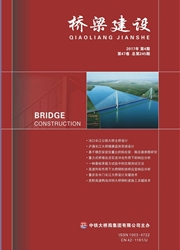

 中文摘要:
中文摘要:
为研究系杆拱桥吊杆节点锚固区锚头强度是否满足受力要求,以南昌生米大桥为研究背景,制作拱顶吊杆节点锚固区的足尺模型,测试在设计荷载作用下吊杆节点承载力,并建立空间有限元模型,对比分析有限元理论值与试验实测值。研究结果表明:双层钢套筒整体强度满足要求,但加劲板与钢垫板接触位置局部抗压强度超过允许值,应对加劲板予以补强。模型试件的制作精度影响内钢管与外钢套筒分担荷载比例,在今后的类似试验过程中应予以重视。
 英文摘要:
英文摘要:
To study if the strength of the anchor head in anchorage zone of the hanger joint of tied arch bridge could meet the load-carrying requirements, the Shengmi Bridge in Nanchang was cited as an example, the full-scale model for the anchorage zone of the hanger joint at arch crown of the bridge was fabricated and the load-carrying capacity of the joint under the action of the de- signed load was tested. The spatial finite element model of the anchorage zone was established and the theoretic values of the finite element and the measurement values of the test were compar- atively analyzed. The results of the analysis show that the global strength of the double-layer steel socket of the hanger joint can meet the requirements, however, the local compressive strength values of the contact between the stiffening plates and the steel padding plate exceed the allowable values and the stiffening plates should be reinforced. The fabrication accuracy of the model has influence on the proportions of the load shared by the inner layer and outer layer of the steel socket and in the future tests of the similar kind, attention should be paid.
 同期刊论文项目
同期刊论文项目
 同项目期刊论文
同项目期刊论文
 期刊信息
期刊信息
